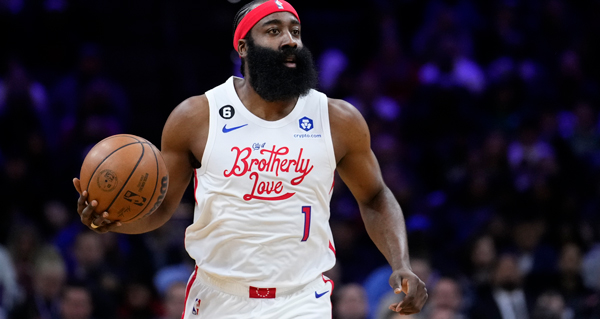It’s a rom-com, really. Here’s James Harden: the work-hard, play-hard perma-bachelor who traffics in such excess that he’s never made room for the seemingly perfect partners who have passed through his life. There’s Joel Embiid, the hardened romantic who’s learned to rely on only himself after a long-term relationship went sour. Alone, they can survive, but not thrive. Together, they can score a mind-bending 123.1 points per 100 possessions. In the end, Harden’s just a guy, standing in front of a guy, asking him to run a pick-and-roll.
They’ll always have Philadelphia.
In merely 47 games together this season, Harden and Embiid have already become a historically prolific assist-scorer battery, putting to rest any concern-trolling about their ability to coexist. Harden has assisted Embiid 235 times this season, 84 more than any other pairing in the league. When Philly’s two stars share the court, the Sixers offense is psychedelically good, scoring at a pace that would shatter the single season offensive rating record. In their first full year as teammates, they’ve helped each other unlearn old habits.
As recently as the bubbled 2019-2020 season, Harden was an unprecedentedly great isolation scorer, averaging 15.8 points per game, the second most isolation points of the last decade (Harden scored 18.1 points per game in isolation the previous year). While Harden still ranks as one of the top-five most prolific soloists this season, he’s reoriented the basic shape of his game. Three years ago, Harden passed 49.5 times per game; now, he dishes nearly 70 of them.
For Harden, this transformation is especially stark: after years of providing melody, Harden is now the harmony. If a younger version of Harden were freed—encouraged, even—to play like he was the intrepid protagonist of reality, he’s now lost some of the necessary oomph to pull that off on a full-time basis. Instead, he’s morphed into a truly elite passer, creating shots for his teammates instead of himself. Like Pokemon or Taylor Swift, Harden evolved as he aged without losing any potency. Naturally, his 21.3 points per game are the fewest since he left the Thunder a decade ago, yet he leads the league with 10.8 assists per game.
In this sense, Harden’s evolution can be read as a restoration to the play-making genius he once was before Houston decided that passing was gauche. Beyond all the obvious, actual basketball stuff, Harden’s fundamental genius has always been his understanding of how his decisions redound outwards for the other nine guys on the court. As a Sixer, he’s rediscovered how to train this on others and not solely on himself. He draws fouls when defenders desperately don’t want to foul him; he slips passes to the areas of the floor where defenses are explicitly arranged to not allow passes.
For the most part, those passes are slipped to Embiid, who’s enjoying the best season of his career. Even accounting for the rampant league-wide points inflation, Embiid’s scoring is without any antecedent or analog—his 33 points per game is the highest single-season average of any center in over 50 years. Alongside Harden, Embiid has the latitude to attack defenses from all areas of the court and is having the most efficient season of his career: it’s not a coincidence that Embiid has his highest True Shooting the same year he’s been assisted on the biggest proportion of his shots.
Having eschewed roll-manhood for the first six years of his career, Embiid is now the most prolific and productive pick-and-roll big man in the league. As the roll-man, he scores 8.3 points on 6.8 possessions per game. While Harden and Embiid both play with the cynicism of guys who seem to know and care about their Synergy Sports percentile rankings, their partnership is something purer and simpler. When they connect for yet another assist, it’s not math—it’s love, actually.
Embiid has emerged as an all-world pick-and-roller by reinventing the play’s basic premise. With Embiid, a pick-and-roll is simply a souped-up expansion of his post game. Rather than heedlessly charging towards the rim, Embiid often catches the ball at the free throw line, allowing him to either float in a wide-open jumper or brutalize an out-of-sorts big man off the dribble.
Whereas a traditional post-up has to be arranged and gives the defense time to gird itself, a pick-and-roll maintains the element of surprise; the defense can’t map out a trap if they don’t know where or when or if Embiid is going to get the ball. Just as the Kansas City Chiefs protect Travis Kelce from double teams by putting him in pre-snap motion, the Sixers use the pick-and-roll as a way to create otherwise impossible one-on-one opportunities for Embiid in the middle of the floor.
Despite an underwhelming 12-12 start to the year, the Sixers have been essentially unstoppable for the last four months, going 39-15 over their last 54 games. But everything about Philly is mere prelude—it’s not a secret that James Harden can pilot an excellent regular season offense or that Joel Embiid can score a bunch of points.
Everything about the Sixers carries the tacit weight of 10 turnover meltdowns and broken faces and should’ve-been dunks and quadruple doinks. Embiid is nearing 30 and Harden might be a flight risk. Each Sixers game carries the dread that an injury or Doc Rivers could upset the delicate promise of the NBA’s most precarious contender. The Sixers’ joy is fragile, their promise freighted with an awful anxiety. As the regular season reaches its end, there’s the sense that fulfillment might exist in some not-distant future as long as Harden and Embiid are able to seize it. When you realize you want to spend the rest of your life with somebody, you want the rest of your life to start as soon as possible.



